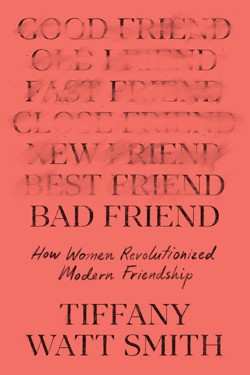One of my favorite monuments looks like it belongs to a married couple. Draped in marble flowers and guarded by fat cherubs, it features two stone portraits joined by a knotted cloth, and script that describes an intimate bond: a “beautiful and unbroken marriage of souls and a companionship undivided during thirty-six complete years.” But this memorial has nothing to do with a husband and a wife. It commemorates a friendship—one between two men, Sir John Finch and Sir Thomas Baines, Renaissance-era doctors who traveled, worked, and lived together in the 1600s and were buried side by side at Christ’s College in Cambridge. “They who while living had mingled their interests, fortunes, counsels, nay rather souls,” reads their tombstone, “might in the same manner, in death, at last mingle their sacred ashes.”
This exuberant expression of love is a far cry from popular depictions of male friendship today, which tend to portray men as struggling with vulnerability, or reticent to form bonds unless prompted by the women in their lives. Of course, Finch and Baines could have been a couple; they lived in a culture that criminalized homosexuality, in which “friendship” might have served as a guise. But a platonic relationship as effusive as theirs also wouldn’t have been out of the ordinary: In their time, across Europe, passionate bonds between men were publicly celebrated, and women were typically viewed as lacking the emotional depth required for true friendship.

Many historians have a ritual they use to shake themselves out of their complacent 21st-century perspectives. When my friend Jo sits down at her desk to write about 19th-century America, she tries to remember that back then, pigs used to wander the streets of New York. While writing my latest book, on the history of friendship, going to Finch and Baines’s monument was my trick. In an age when women’s friendships are widely idealized—think Sex and the City‘s foursome and pink glitter T-shirts that read Best Friends Forever—Finch and Baines’s memorial helped remind me that the cult of female friendship hasn’t always been the norm, and that the way friendship is viewed now may not be how it’s viewed forever.
I’m a historian of emotion: I study how cultural narratives act on people as individuals—and how changing social factors play out in our hearts and homes. Scholars in my field often talk about the concept of “emotional communities” to understand how the behavior connected to a particular feeling can change across time and place. An emotional community shares expectations about which emotions should be felt—which are shown, which are hidden, how each should be expressed. Such rules are enforced through institutions such as schools and courts, and via literature, art, and the rituals of family life.
As a society’s emotional rules change, so do the ways individuals expect to feel—including in friendship. Psychologists have shown that, far from following a universal template, friendship has “styles” that differ subtly from place to place. According to the psychologist Roger Baumgarte, some cultures, such as that of the United States, seem to favor a more “independent” style of friendship, in which friends are highly respectful of one another’s autonomy and might become uncomfortable if they sense that someone is overstepping a boundary. In other cultures, such as those of Cuba or China, friends are expected to “intervene” more in a friend’s life and might feel snubbed if help is not given. Although this kind of research can quickly give way to reductive stereotypes, it does illuminate how diverse people’s expectations about friendship can be.
These expectations can also change across time. Finch and Baines’s 17th-century emotional community, for instance, was shaped by highly romantic ideas about male friendship. The two men lived toward the end of a period of astonishing intellectual transformation in Europe, when artists, politicians, scientists, and philosophers had rediscovered, via the scholars of the Islamic Golden Age, great works of classical antiquity and wanted to make their ideals their own.
One such work, Aristotle’s Nicomachean Ethics, written in the fourth century B.C.E., divided friendship into three tiers. The bottom two tiers were populated by ordinary kinds of friends, in what he called friendships of utility and friendships of pleasure (the only kinds that women were supposedly capable of). Friendships of utility, Aristotle wrote, were “commercially minded,” based on mutual help and quid pro quo. Friendships of pleasure were bonds formed through diversion and entertainment: You might gravitate toward a friend because they make you laugh, or you might sit with them at a game because they support your favorite athlete. But the third tier, which Aristotle called “perfect” friendship, was something else—a bond between two men “alike in virtue,” who saw each other as a “second self.” It was, as later philosophers explained, as if “one soul dwelled in two bodies.” This is how Baines and Finch saw themselves. They strove to be “perfect” friends, and by all accounts, they seem to have succeeded.
Another Renaissance figure who believed himself to be a “perfect” friend was the French philosopher Michel de Montaigne, whose essay “On Friendship” continues to influence writing on the subject today. In his bond with Étienne de La Boétie, a fellow lawyer and author, de Montaigne believed that he had found the kind of ideal friendship that only a few men in a generation could possibly hope to achieve—and his essay is a soaring depiction of their transcendent connection. In one of the most quoted lines in the history of friendship, he writes: “If you press me to say why I loved him, I feel that it cannot be expressed except by replying: ‘Because it was him: because it was me.’”
Like other intellectuals of the time, de Montaigne did not consider women capable of this ideal. Women’s brains could not endure this “clasp of a knot so lasting, and so tightly drawn,” he wrote. His claim was based on the era’s misogynistic medical theories, which held that women’s brains were colder and weaker than men’s. Women were willows, explained the scientist and poet Margaret Cavendish in 1655, liable to bend in the smallest draft—not sturdy oaks. In this way, most women were declared too flighty, capricious, and stupid for the commitment that true friendship required. They were also thought to be too easily distracted by romantic relationships with men. “The reason why most women are so little affected by friendship,” wrote the 17th-century French nobleman François de La Rochefoucauld, “is that it tastes insipid when they have felt love.”
Women’s friendships from this era were not generally memorialized in stone or glorified in reams of soaring poetry. In the archives, their stories appear as fragments compared with the large, easily accessible corpus on male friendship. But certainly they existed. In my research, I found evidence of women’s bonds in scraps and shards—glimpses of women grieving over their deceased friends or helping one another through illnesses, evidence of friends forming households and raising children together, running joint businesses, defending others in court. Men knew the power of these alliances. Friendships gave women agency in a world not designed for them. It is perhaps no wonder that their friendships tended to be dismissed.
Within 100 years of Finch and Baines’s burial, the rules of their emotional community began to shift. The second part of the 18th century was a period of revolutionary fever and social reform across Europe and America. As abolitionist, women’s-rights, and anti-poverty campaigns gathered momentum, so did discussions about emotion and sympathy (the old word for empathy). Poets, artists, and philosophers in this new Age of Sensibility began to speak in reverent tones of the supposed heightened sensitivity of “the female mind.” They helped advance the idea that women enjoyed some special skill in friendship—and were capable of deeply emotional connections with the poor, the disenfranchised, and one another.
By the 19th century, though, this belief in women’s empathy had hardened into a new ideal of middle-class Victorian femininity: the “angel of the house.” The consummate woman was supposed to be tender, loving, and eternally supportive; devoted friendships were seen as proof of her compassionate nature. Girlhood bonds were considered practice for the affection and sacrifice necessary for future roles as wives and mothers. Often, girls were primed with stories of highly romantic female friendships: One popular collection of nursery tales depicts two friends, Beatrice and Alice, who “loved each other dearly” and “with their arms about each other would sit under the deep shadow of the trees listening for the cuckoo’s notes.” In Victorian novels, the girls who enjoy intimate childhood bonds—think Jane Eyre and Helen Burns—grow up to win the prize of marriage and motherhood, and “difficult,” solitary, awkward girls, such as Lucy Snowe in Villette, marry unhappily, if at all.
Romantic friendships between men didn’t fall completely out of favor during this time. Photographs from the 1850s to the early 1900s show male friends holding hands or draping their arms around each other; sentimental letters between men in this period also abound. But by the second half of the 19th century, a new narrative about men’s friendships was on the rise. Some began to depict male friendships as blundering and superficial. And as gay culture became more visible, and European sexologists stoked fears of “sexual inversion,” a growing self-consciousness around male intimacy emerged. In 1863, the English feminist campaigner Frances Power Cobbe published an essay, “Celibacy v. Marriage,” in the widely read Fraser’s Magazine, in which she reiterated what had by then become a familiar story about male and female friendships. Whereas women friends enjoyed “one of the purest of pleasures and the most unselfish of all affections,” Cobbe wrote, to men, friendship was little more than forming an “acquaintance at a club.”
Americans still, to an extent, live among the ghosts of these Victorian forebears, holding women to high standards of intimacy and portraying male bonds as clumsy and inept. We also live in an age of social fragmentation, in which experts, worried about loneliness and isolation, are puzzling over how to bring people together. To foster more connections, we’ll need to reexamine our emotional rules—which ones are worth preserving and which ones we might be better off without. As a historian, I can tell you this: If we want to reimagine the terms of friendship, we can.
*Lead image credit sources: Fitzwilliam Museum / Bridgeman Images; Harris Brisbane Dick Fund / The Met; Royal Institute of British Architects / The Met
The post When Men Weren’t Afraid to Love Their Friends appeared first on The Atlantic.




